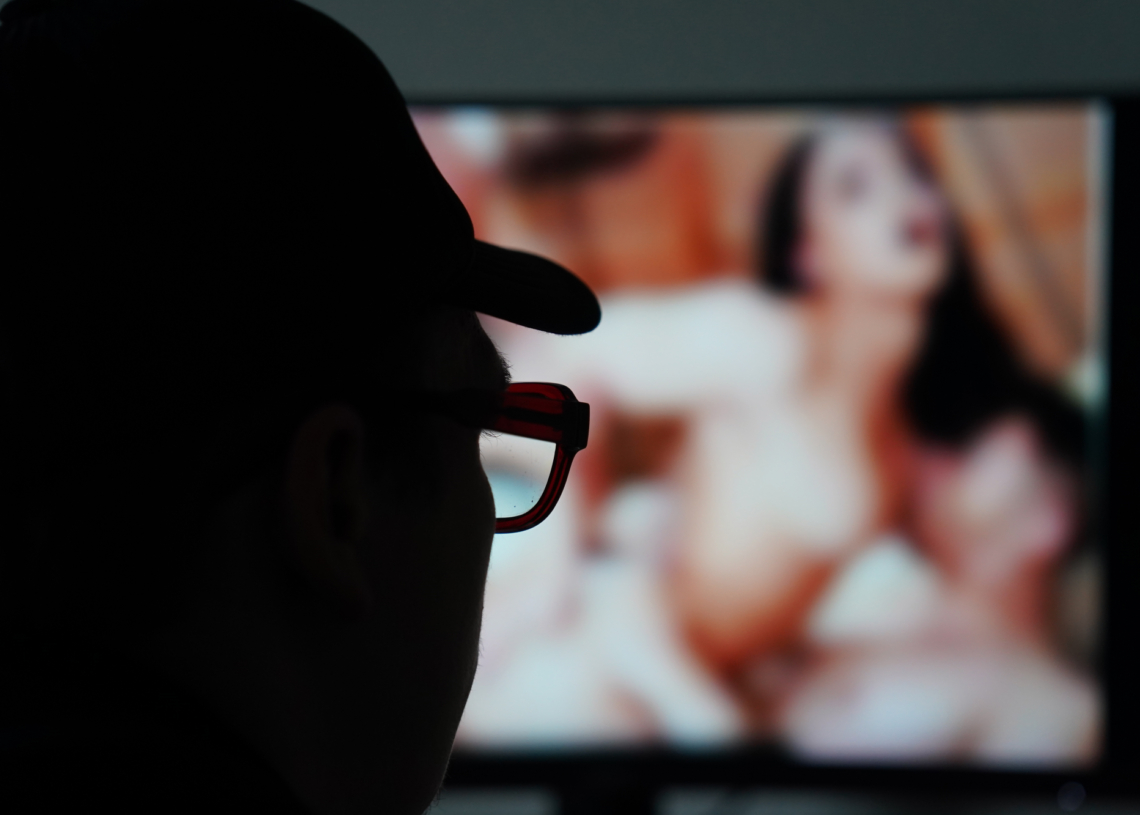This is the fourth instalment of Drew Austin’s VICE column, MILLENNIAL PAUSE. Read his previous column here and find him in each issue of VICE magazine—subscribe today.
When I’m home for the evening and want to relax, I’ll put something on the TV—usually whatever game is happening—then sit down on the couch with my laptop or a book, make sure my phone is also close at hand, and finally put on some music, as a sort of audio bed for the sports announcers’ voices. The social media feeds, the browser tabs, the group chats, the game, the voices, the music, the text—all that content—blend together into a slurry of information that washes over me. I don’t exactly absorb it because there’s too much, but the overall effect is calming. It’s a mundane pastime, to be sure, but it also feels like I’m living in the future, a conduit for the networked data flowing toward me from multiple directions. “People don’t actually read newspapers, they get into them every morning like a hot bath,” Marshall McLuhan wrote 50 years ago; today the media bath is more alluring than ever.
I recognized a dark version of my own digital consumption habits in Daniel Kolitz’s recent viral Harper’s piece about gooning, which introduced a wider audience to a lurid subculture that, like porn itself, is never far from the internet’s main thoroughfares, and often just one wrong turn away (or right turn, depending on what you’re after). Gooning is a novel form of prolonged porn viewing, but more broadly, it is a different way of consuming media, and perhaps better suited to the current landscape—something more like full immersion, an ongoing effort to merge one’s consciousness with the almighty digital stream (Kolitz reports that some gooners conceive of porn as an “entity” or “goddess” that demands constant fealty). Confronted with a massive surplus of content that is being shoved into our faces at all times, which is harder than ever to avoid or even limit, we need new ways to process it, and gooning is one such response to the excess. “It’s hard not to see goonerism as just an intensification, almost a burlesque, of prevailing cultural trends,” Kolitz writes; his piece suggests that gooning is as much about one’s relationship to the digital landscape as anything purely sexual.
A basic tension that animates gooning is that there is too much porn and too little time to watch it all. Gooners are used to rapid-fire skimming of video clips, as enabled by streaming platforms like PornHub, and “have grown accustomed to a degree of stimulation that most porn isn’t equipped to satisfy.” That tension is resolved in a new format, the “porn music video” or PMV, a frenetic, hyperdense supercut of existing clips that “enshrines this rapid-fire mode of porn consumption as a compositional principle.” Kolitz describes it as “freebase pornography—porn purified of anything that might disrupt its swift passage to the brain.” This compression of vast source material is thus a “logical response to the glut.”
“Gooning is as much about one’s relationship to the digital landscape as anything purely sexual”
Older millennials, who have wallowed in that glut for much of their adult lives, seem amused or horrified by the gooning phenomenon, or at least puzzled, as is often the case when they encounter a new facet of Gen Z culture. Few have expressed any indication that they understand or relate to it, even if they secretly do. Every generation has its own fraught relationship to the internet, of course: Boomers credulously dive in headfirst, unbothered by all that they don’t know and eagerly oversharing. Gen X is more savvy and more skeptical, perhaps constrained by the self-consciousness that boomers lack. Millennials, the first generation native to the internet, are confident they know how it all works, but still bring their hazy memories of analog childhood online with them, trying in vain to preserve some part of themselves from digital intrusion, attempting to limit their screen time and then feeling guilty about constantly failing to do so.
In an essay about the technological evolution of photography, architecture historian Kazys Varnelis describes what happens when “systems of cultural production exceed their capacity for meaningful absorption or engagement.” Not only are we unable to stop creating content, he argues, but the more we create, the less we are able to meaningfully engage with any of it. “The tourist’s compulsion to document rather than experience mirrors the academic’s pressure to publish rather than think, the artist’s need to exhibit rather than develop, the writer’s push to post rather than reflect. In each case, the system demands constant production while making deep engagement increasingly impossible,” Varnelis writes. Even conscious efforts to resist this oversaturation are absorbed by it, with efforts to “digital detox” or “touch grass” often becoming more content themselves.
The most common millennial response to this condition, it seems, is anxiety, expressed as a studious desire to manage the content glut, like an expanding mountain of homework the internet has assigned to us that we always feel like we’re supposed to finish. Apps like Instapaper and productivity hacks like Inbox Zero, 1.5x-speed podcasts and videos, and the movement to limit screen time and resist internet brainrot altogether reflect the residual mentality of a time when there was much less to read, watch, and listen to, and it felt slightly more plausible that one might eventually get to it all. Who hasn’t noticed their various queues of content grow longer by the day, knowing you’ll never so much as glance at most of it, yet feeling unable to just delete everything and start over.
The culture around gooning, and the PMV in particular, suggest that Gen Z has adopted a different response to the content surplus: compression. You can never work your way through the queue, but you can watch a highlight reel that distills each piece into a single representative second. You can let it all flow by you like a great river, basking in its glow for hours without ever perceiving distinct units of content, simply enjoying the stream of information as a totality—letting the medium overwhelm the message. You can move through the internet with a lighter touch.
This is what everyone else already does too, by the way, but not all have fully embraced it yet. “You’re all caught up,” the Instagram app congratulates users when they’ve finally scrolled to the end of their feeds and seen every post from their followers; TikTok would never suggest that such an end point existed, or that seeing every post was a valid goal, much less that either would be something to celebrate. To the extent that AI shapes digital experience more and more, the sheer volume of content will continue to grow exponentially as the value of engaging with it directly decreases, necessitating more compression and summarization.
“You can let it all flow by you like a great river, basking in its glow for hours without ever perceiving distinct units of content, simply enjoying the stream of information as a totality—letting the medium overwhelm the message”
Gooning, then, is merely a model for how we all use the internet now. “The gooners’ rise does, in retrospect, possess a certain inevitability,” Kolitz writes. “Anyone paying attention to online porn’s evolution over the preceding 20 years could sense, in its brain-melting variety and abundance, the blueprint for a new kind of person.” The gooner turns his back on the real world, with all its uncertainty and discomfort, and abandons the possibility of agency, retreating into the network, transcending the self and becoming a node, striving to relay information back and forth to others with maximum efficiency—what cyber-theorist Arthur Kroker called “a cool hallucinatory culture of special effects personalities moving at warp speed to nowhere.” Content consumption is only passive if you’re outside of it, after all, not if you’re part of it. The material world is difficult but its digital mirror is abundant; the metaverse may have been a bust but maybe this here is the real version.
In the wake of the 2008 financial crisis, the millennial generation entered the Obama era with an optimistic change-the-world energy that zero interest-rate policy, or ZIRP, redirected into the digital simulacrum, where the returns were higher. It would prove impossible to float on this cloud forever but it was good while it lasted, and ZIRP built out the robust social media hellscape that Gen Z had no choice but to inhabit. If gooning is ultimately just the prolonged act of mainlining content at the expense of the outside world then millennials have been doing it too, for a while—the only difference is they never realized it.
This is the fourth instalment of Drew Austin’s VICE column, MILLENNIAL PAUSE. Read his previous column here and in each issue of VICE magazine—subscribe here.
Find more of Drew Austin’s writing at his Substack, Kneeling Bus
The post Gooning: A Logical Response to a World of Infinite Slop appeared first on VICE.




